Science Term 3: Biology
Vocabulary:
Monomers and polymers:
Phosphodiester bond: Nucleotides are connected to form polynucleotides through the sugar-phosphate backbone thanks to this covalent bond.
Directionality: Nucleotide strands run in a 5’ → 3’ direction
Purines: Double-ringed chemical compound found in nitrogenous bases. Adenine and Guanine
Pyrimidines: Single-ringed chemical compound found in nitrogenous bases. Cytosine, Thymine, and Uracil.
Complementary pairs: Nitrogenous bases connected via hydrogen bonds. Has to be exact. Cytosine - Guanine (3 H-bonds) and Adenine - Thymine/Uracil (2 H-bonds).
Messenger RNA (mRNA): transcript copy of a gene that reads the sequence in base triplets (codon) in the ribosome.
Ribosomal RNA (rRNA): responsible for the synthesis of protein in ribosomes.
Transfer RNA (tRNA): serves as the physical link between the mRNA and the amino acid sequence that will align opposite to a specific codon, transporting the latter to ribosomes.
Genes:
Gene: a specific sequence of DNA that encodes for a particular protein. Heritable
Locus (p: loci): specific position of a gene on a chromosome
Alleles: different possible variations of a gene
Gene mutation: change in the nucleotide sequence of a gene
Somatic: occurs in body cells and cannot be inherited
Germline: occur in sex cells (gametes) and is inherited
Genome: The complete set of DNA in an organism
Human genome: 46 chromosomes.
Gene splicing: The process used to add a gene into or remove genes from DNA.
Gene therapy: The process of replacing a defective gene with a normal gene.
Pluripotent embryonic stem cells: Cells that are able to self-renew by dividing and developing into the three primary groups of cells that make up a human body
Chromosome:
Chromosome: Single double-stranded DNA molecule
Plasmids: Autonomous genetic structure that can replicate independently of the chromosome, usually in prokaryotes.
Nuclear pores: a large complex of proteins that allows small molecules and ions to freely diffuse in and out of a nucleus
Cytosol: Aqueous component of the cell cytoplasm, in which various organelles and particles are suspended.
Diploid: two copies (complete set) of each chromosome (2n)
Haploid: one copy of each chromosome (n)
Homologous chromosomes: Paired maternal and paternal chromosomes found in diploid organisms.
Karyograms: Chromosome profile of an individual organism
Chorionic villi sampling: Cells are extracted from the placental tissue. Collected earlier (~11 weeks) - higher risk (1%).
Amniocentesis: Cells are extracted from the amniotic fluid. Collected later (~16 weeks) - lower risk (0.5%).
Autoradiography: A technique used to visualize uncondensed chromosomes by John Cairns.
Aneuploidy: The condition of having an abnormal number of chromosomes in a haploid set.
Polyploidy: The condition of having an abnormal number of chromosome sets due to malfunction of cytokinesis.
SIngle nucleotide polymorphism: Locations on chromosomes that differ by only one base from one human to another.
DNA → Protein:
Replication:
DNA replication: Duplicate DNA to create identical sister chromatids prior to cell division.
Transcription: Synthesise an RNA sequence from a DNA template.
Translation: The mRNA transcripts code for the production of polypeptides in ribosomes.
Semi-conservative: When new DNA molecules form they are composed of one strand from the original template and one newly synthesized.
Helicase: Enzyme that separates the DNA strands by breaking the hydrogen bonds between complementary base pairs.
Polymerase: Enzyme that covalently joins free nucleotides to their exposed complementary base pairs by using the energy from cleaving two of the phosphates.
Polymerase chain reaction:An artificial method of replication used to rapidly amplify DNA sequences.
Transcription:
RNA polymerase: Binds DNA and breaks the H-bonds and covalently joins RNA nucleotides
Antisense strand: RNA strand that is transcribed (the sequence is complementary to RNA script)
Sense: RNA strand that is not transcribed (the sequence is identical to script - except for T and U).
Translation:
Peptide: Two amino acids linked in a chain. Has a carboxyl and amino terminus.
Universality: All organisms use the same genetic code (few viral exceptions)
Degeneracy: More than one codon may code for the same amino acid, allowing silent mutations.
Cell division:
Cell cycle:
Interphase:
Interphase: An active period in the cell cycle where many key metabolic processes occur.
G1 phase: cell growth and metabolism.
S phase: DNA replication. The replicated chromosomes will consist of genetically identical sister chromatids.
G2 phase: cell growth and proof-reading
Chromatin: a mixture of DNA and proteins found in cells normally.
Chromosome: Chromatin strands that are condensed for mitosis.
Chromatid: one of the two identical halves of a chromosome
M phase:
Mitosis: Nuclear division, whereby each pair of sister chromatids are separated into two identical daughter nuclei.
Cytokinesis: Cytoplasmic division.
Prophase: DNA supercoils and chromosomes condense, the nuclear membrane breaks down, and centromeres go to opposite sides.
Metaphase: Mitotic spindle connects centromeres and centrosomes, aligning the chromosomes to the center.
Anaphase: Spindle fiber contracts, separating the sister chromatids.
Telophase: Chromosomes de-condense as the nucleus reforms. Cytokinesis occurs concurrently.
Cytokinesis (in animals): Microtube filaments form a cleavage furrow that contracts. it is centripetal.
Cytokinesis (in plants): vesicles form at the center of the cell to form a cell wall. It is centrifugal.
Cyclins: A family of regulatory proteins that control cell cycle progression.
Necrosis: Uncontrolled cell death
Apoptosis: Controlled cell death
Cancer:
Cancer: caused by uncontrolled cell division.
Tumors: abnormal cellular growths formed as a result of cancer
Metastasis: The spread of cancerous tissue
Mutagen: an agent that causes a change in the genetic material of an organism. Can be physical, chemical, or biological
Carcinogens: Mutagens that cause cancer.
Oncogene: A gene that has the potential to cause cancer.
Meiosis:
Meiosis: Cell division for gametes.
Gametes: Haploid sex cells produced by sexually reproducing organisms. Female: ovum. Male: sperm.
Gametogenesis: the production and differentiation of gametes from haploid cells.
Bivalents: Homologous chromosomes associated in pairs.
Chiasma: The contact point between the two chromatids of a chromosome during meiosis.
Chiasmata: a point at which paired chromosomes remain in contact during the first metaphase of meiosis
Crossing over: Homologous chromosomes connect via chiasmata to form bivalents (tetrads) and exchange small portions of genetic information.
Random assortment: Homologous chromosomes line up in random orientation during metaphase I, giving humans 2^23 gamete combinations.
Gamete fusion: The diploid zygote will contain genetic formation from both parents’ gametes.
Non-disjunction: Chromosomes fail to separate during anaphase I or II, causing aneuploidy.
Inheritance:
Law of Segregation: Alleles are separated when haploid gametes form.
Law of Independent Assortment: The separation of alleles for a particular gene is independent of any other gene.
Genes on the same chromosome do not independently assort.
Principle of Dominance: Recessive alleles will be masked by dominant alleles.
Alleles: Variations of a specific gene.
Three types of allele combinations:
Homozygous: Alleles are the same.
Heterozygous: Alleles are different.
Hemizygous: There is only one allele.
Genotype: Allele combination for any given characteristic.
Phenotype: Physical expression of a characteristic influenced by genotype and environment.
Complete dominance: One allele is expressed over another in the phenotype. Capital for dominant and normal for recessive.
Co-dominance: both alleles are expressed equally in the phenotype. Uses superscripts
Sex-linked: Alleles are located on sex chromosomes.
Pedigree: a genetic history of a family over several generations.
Pure breeding: Where all individuals have the same genetic information through generations.
Mutations:
Mutagen: An agent that changes the genetic material of an organism. Physical, chemical, or biological in origin.
Point mutation: Modification of a single nucleotide within a sequence. Substitution, transition, and transversion.
Substitution mutations can cause:
Silent mutation - No change to the polypeptide sequence.
Missense mutation - A single amino acid is changed in the polynucleotide.
Nonsense mutation - A stop codon (three consecutive nucleotides) is created, truncating (shortening) the polypeptide.
Transition: substitution of one purine for another purine or one pyrimidine by another pyrimidine.
Transversion: substitution of a purine by pyrimidine and vice versa.
Frameshift mutation: The result of the addition or deletion of nucleotides in the sequence of DNA, causing a shift of the reading frame of mRNA.
Insertion mutation: Addition to the nucleotide sequence that causes frameshift mutations (changes the reading frame)
Deletion mutation: Removal of parts of the nucleotide sequence that causes frameshift mutations (changes the reading frame).
Evolution:
Evolution: Cumulative change in the heritable characteristics of a population. It is the change in frequency of a gene pool across generations.
Gene pool: Sum total of all alleles present in a population.
Gene flow: The movement of genes between disparate populations via immigration or emigration.
Genetic drift: Change in gene pool composition due to chance events.
Population bottlenecks: An event reduces population size by an order of magnitude (>50%)
Founder effect: When a new population is established as a small subset of a larger population.
Artificial selection: Humans determine the trait by DNA manipulation.
Natural selection: Change in the composition of a gene pool as a result of selective environmental pressures.
Adaptations: Features that make an individual suited to their environment.
Analogous: Structures that appear similar or have the same function but are unrelated.
Australopithecus: A genus in the family Hominidae that is probably ancestral to the genus Homo.
Cross-breeding: Selective breeding combines a desirable feature with an individual desirable feature from another.
Generation: Time between birth and their own offspring.
Hominidae: The family to which humans belong
Homo: The genus to which humans belong.
Hybrid: Offspring of parents with different genotypes.
Inbreeding: Selective breeding between two closely related individuals
Linnaean classification: A hierarchical system of classifying organisms aimed at reflecting their evolutionary relationships.
Morphology: The physical form or structure of an organism.
Selection pressure: The effects of the selective agents on a population.
Selective agent: An environmental factor that acts on a population during natural selection
Sexual selection: Natural selection where the environmental factor is the selection of a mate.
Classification:
Artifical classification: Classifies species based on non-predictive features. Easy to develop and stable, but are not commonly used because they don’t consider species relatedness.
Natural classification: Classifies species based on evolutionary relationships. Highly predictive and mutable.
Phylogenetic: Classifies species based on genetic features.
All living organisms are categorized into 3 domains:
Eukarya: eukaryotic organisms.
Archaea: extremophilic prokaryotic organisms.
Bacteria: common prokaryotic organism.
Taxon (pl. taxa): Standard classification unit of organisms derived from a single common ancestor.
Dichotomous keys: A method of identification where a group of organisms is repeatedly divided into two categories until each organism has been identified.
Plant phyla list: Bryophyte, filicinophyte, coniferophyte, angiosperms.
Animal phyla list: porifera, cnidaria, Platyhelminthes, annelids, molluscs, arthropods, chordates
Vertebrata classes list: Fish, amphibians, Reptiles, Birds, and mammals.
Speciation:
Stabilizing: An intermediate phenotype is featured over the extremes.
Directional: One phenotypic extreme is selected at the expense of another.
Disruptive: Both extremes are selected over an intermediate phenotype.
Speciation: An evolutionary process that results in the formation of a new species
Species: Organisms that can interbreed to produce fertile, viable offspring.
Phyletic Gradualism: Speciation resulting from a continuous change at a constant pace as a result of the gradual accumulation of genetic mutation over time. Supported by intermediate phenotypes in fossil records.
Punctuated Equilibrium: Speciation resulting from abrupt bursts that intersperse periods of stability, usually by rapid environmental changes. Supported by many gaps in fossil records.
Two main mechanisms by which speciation can occur:
Allopatric speciation: Divergence due to geographical isolation.
Sympatric speciation: Divergence within the same geographical location.
Pre-zygotic: Barrier that occurs before fertilization can occur (no offspring are produced)
Post-zygotic: Barrier that occurs after fertilization (offsprings are not viable or infertile)
Evidence for evolution:
Paleontology:
Fossils: Preserved remains or traces of organisms from the remote past.
Fossil record: Totality of fossils discovered and undiscovered.
Law of fossil succession: Over time changes occur in ancestral organisms with different species appearing in the fossil records in a systematic order.
Transitional fossil: An intermediary form of an evolutionary pathway that connects species to its ancestor or predicted descendant.
Comparative anatomy (homologous structure):
Homologous structures: Characteristics that share a common basic structure but used in different ways.
Adaptive radiation: A rapid increase in the number of species with a common ancestor when members occupy niches with different conditions.
Niche: The role an organism plays in a community
Vestigial organs: Reduced remnants of functional organs present in ancestors
Selective breeding:
Biogeography:
Biogeography: Distribution of life forms over different geological areas.
Notes:
Nucleic acid
DNA and RNA are made out of nucleotide monomers which contain: pentose (5C) sugar, a phosphate group, and a nitrogenous base.
DNA | RNA | |
|---|---|---|
Pentose sugar | Deoxyribose | Ribose |
Nitrogenous base | Thymine (T) | Uracil (U) |
Number of strands | Double-stranded (double-helix) | Single-stranded |
Basic function | Master copy of genetic instructions | A temporary copy of specific instruction |
Contributed to the foundation of the double-helix model: Watson, Crick, Pauling, Levene, Chargaff, Franklin.
Bind | Shape | |
|---|---|---|
Prokaryotes | Naked (not bound to protein) | circular |
Eukaryotes | Bound to histone protein | linear |
DNA → Chromatin → Chromosome
Chromosomes
Prokaryotes:
No nucleus
DNA contained in nucleoid
Single chromosome (genophore)
Circular and naked
Genome more compact (usually no intron)
may contain extra DNA molecules in addition to the genophore, known as plasmids.
Eukaryotes:
Stored in a membrane-bound nucleus
Nuclear pores allow the transport of RNA to the cytosol
Multiple linear chromosomes
DNA bound to histone proteins to form chromatin
Genome less compact (has many introns)
Exist as uncondensed chromatin except during cell division
Gene loci can be identified according to chromosome number, arm, and banding region
Homologous chromosomes:
Identical structure features (size, band pattern, etc.)
The same genes at the loci positions.
Because paired chromosomes were of different origins (paternal and maternal), the alleles may be different.
The 23rd pair of chromosomes is a heterosome because sex determination requires distinct chromosomes. Male (XY) and Female (XX).
Karyograms:
Homologous pairs are arranged by length.
Chromosomes there were arrested during mitosis.
Used to identify sex or find abnormalities (aneuploidy).
DNA → Protein:
DNA replication | Transcription | Translation | |
|---|---|---|---|
When it occurs | S phase | Always | Always |
Location | Nucleus | Nucleus | Cytoplasm |
Key components | Enzymes | Enzymes | Ribosomes |
Function | Duplicate genetic information prior to cellular division | Produces RNA transcript of a DNA sequence | Makes proteins according to the RNA transcript |
DNA replication:
Semi-conservatism:
Each nitrogenous base needs its complementary pair so the base sequence is conserved.
Meselson-Stahl’s experiment supported the semi-conservative replication theory.
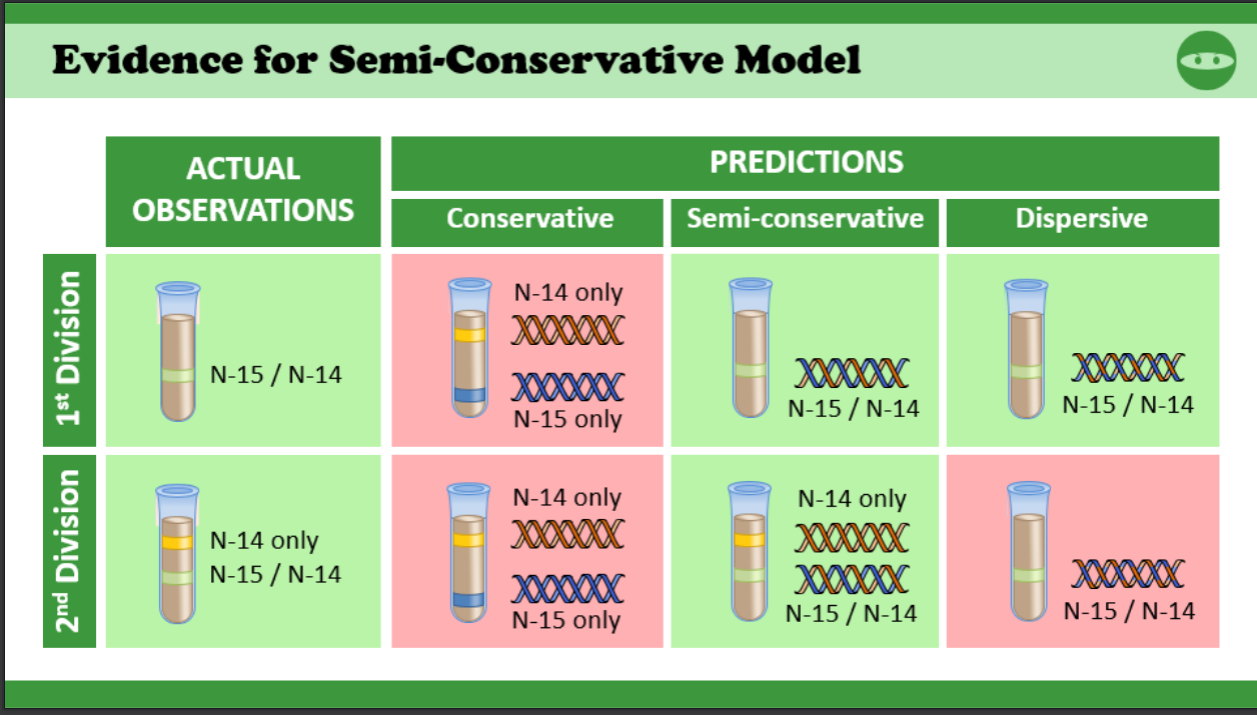
Polymerisation:
New nucleotides align opposite their complementary base pairs as dNTPs (deoxyribonucleoside triphosphate)
Synthesis occurs in a 5’ → 3’ direction.
Polymerase chain reaction:
There are three steps:
Denaturation: Heat separates strands (no helicase)
Annealing: Primers designate copying sequence.
Elongation: Taq polymerase copies the sequence.
Transcription:
The enzyme ^^RNA polymerase ^^separates the DNA strands and synthesises an RNA copy (no helicase).
After transcription is complete, the RNA sequence is released, and the DNA double helix reforms.
The RNA then moves to the cytoplasm for translation.
Sense:

Translation:
An mRNA transcript is organized into triplets of nucleotide bases known as codons.
Cell division:
Cell cycle:
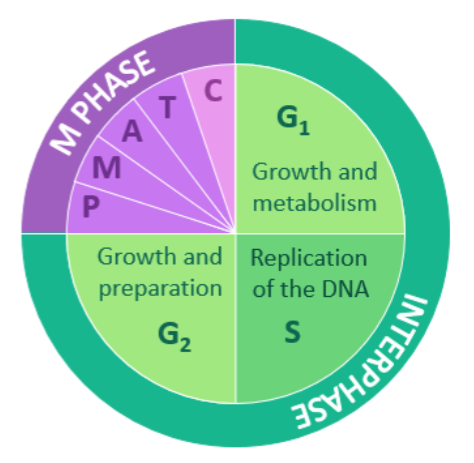
Interphase:
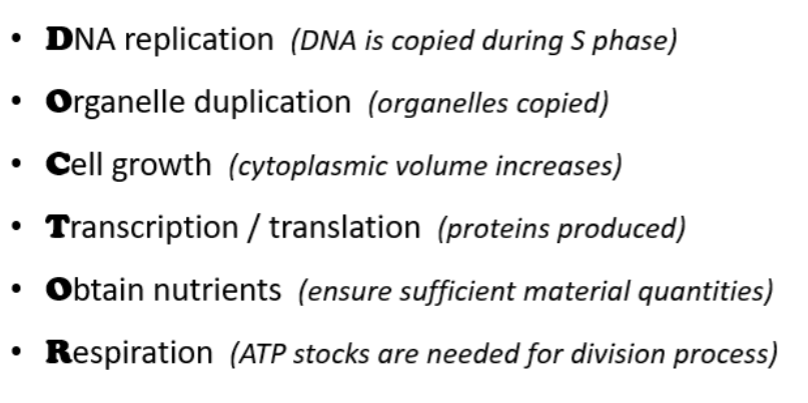
M phase:
Functions of Mitosic Division:
Tissue repair.
Organismal growth
Asexual reproduction
Development of embryos
Meiosis:
The first division separates the homologous chromosomes, turning them from diploid to haploid.
The second division separates the sister chromatids- a mitotic division of haploid cells.
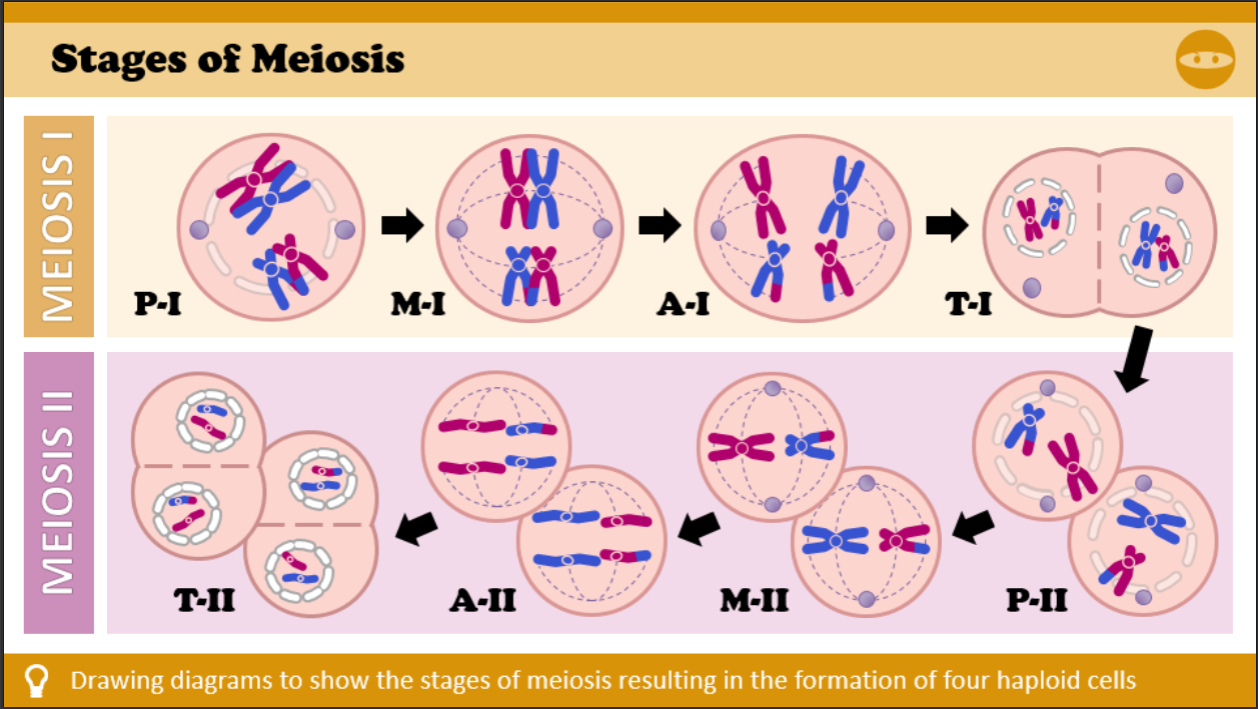
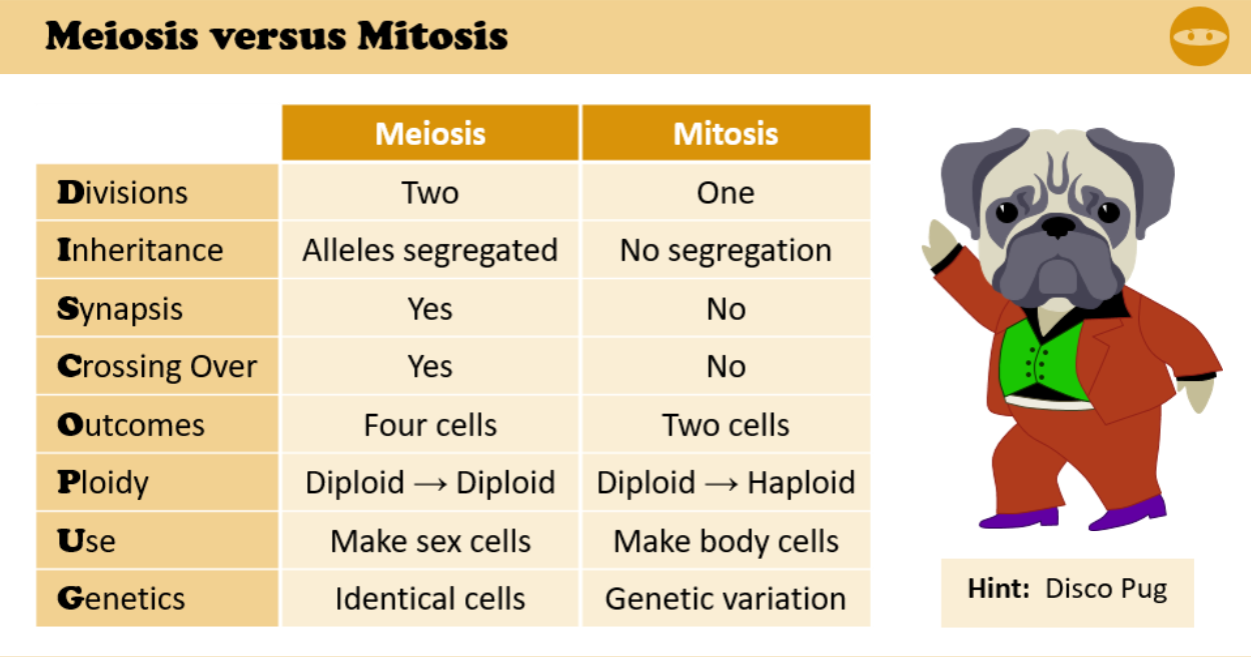
Three ways meiosis promotes genetic variation:
Crossing between non-sister chromatids (prophase I)
Random assortment of homologous chromosomes (metaphase I)
Fusion of gametes from different parents.
Non-disjunction:
Anaphase I: all four daughter cells will be affected:
Anaphase II: two daughter cells will be affected.
Inheritance:
Pedigree:

Mutations:
Genetic disorders include:
Single gene disorder: When a mutation to a single gene alters or abrogates protein function.

Chromosomal abnormalities
Mitochondrial diseases
Multifactorial disorders
Sickle cell anemia: Caused by the change in nitrogenous base substitution in hemoglobin, altering the red blood cell shape into a sickle that can’t carry oxygen as effectively, leading to anemia.
Huntington’s disease: Autosomal dominant disorder caused by a mutation to the HTT gene (chromosome 4) and will cause neurodegeneration, leading to dementia.
Cystic fibrosis: Autosomal recessive disorder caused by a mutation to the CFTR gene (chromosome 7) that produces thick mucus that clogs the airways and digestive tracks.
Red-Green colour blindness: X-linked recessive condition caused by a mutation in the red-green photoreceptors.
Haemofilia: X-linked recessive condition that is caused by mutations in coagulation factors resulting in sustained bleeding.
Evolution:
Evolution requires a source of change and a mechanism of change.
Sources for change (variation):
Genetic mutations
Sexual production
Gene flow (migration)
Mechanisms of change (selective pressure):
Genetic drift
Natural selection
Artificial selection
Genetic drift:
Greater when the population is smaller.
Enhanced by population bottlenecks or the founder effect.
Natural selection:
Survival of the fittest.
Genotype frequency:
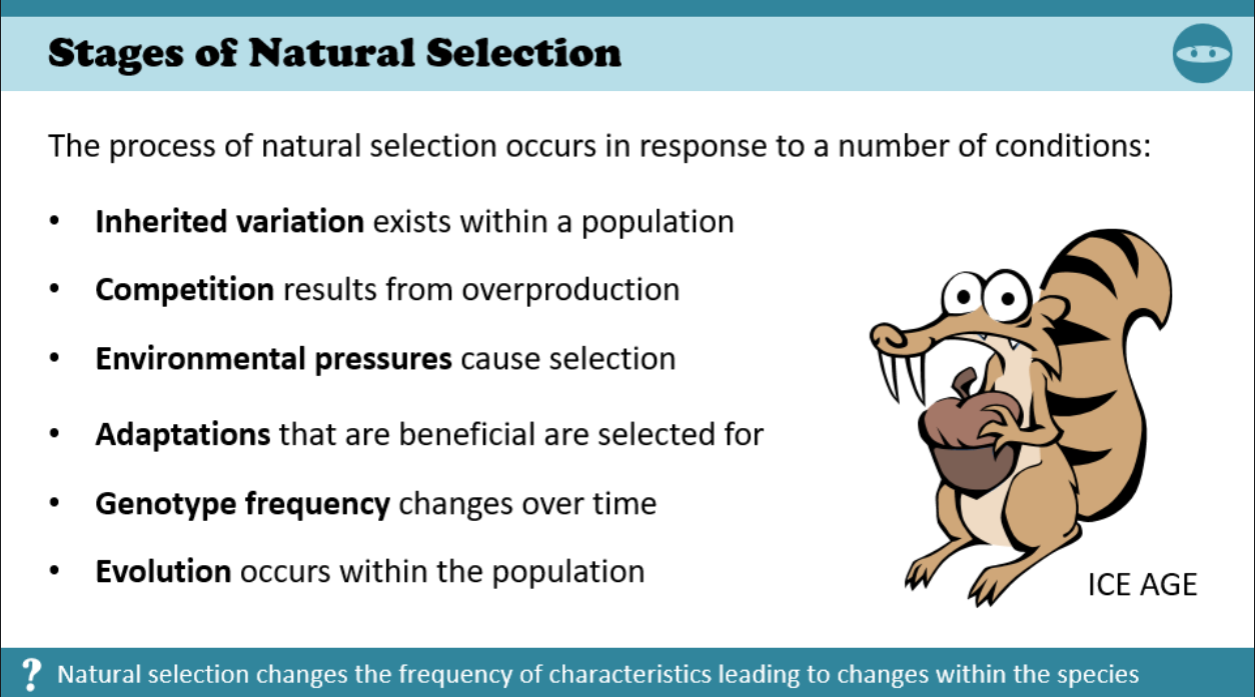
Better-adapted individuals live longer and reproduce more, and vice versa,
Results in a change in allele frequency as certain genotypes become more important.
Classification:
Purpose:
Collect, sort, and group information about organisms.
Enable identification of organisms with a collective understanding
Comparison of organisms.
Show evolutionary links.
Nucleus | Ribosomes | Histone | Introns | |
|---|---|---|---|---|
Eukarya | Present | 80 S | Present | Present |
Archaea | Absent | 70 S | Present | Present |
Bacteria | Absent | 70 S | Absent | Absent |
Taxon:
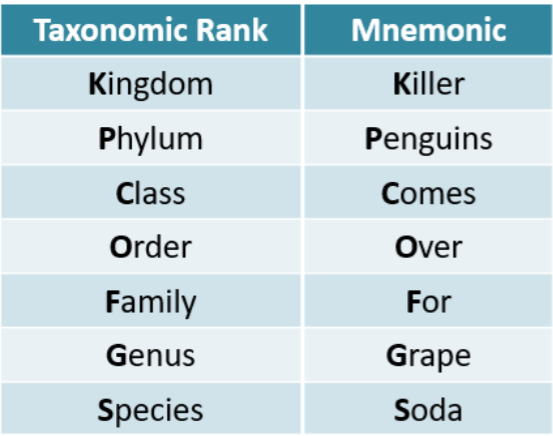
Binomial nomenclature system:
The genus is written first and capitalized (e.g. Homo)
Species follow in lowercase (e.g. sapiens)
Organisms may have a sub-species designation.
All species have a common name.
Speciation:
Three main types of natural selection:
Stabilizing selection:
An intermediate phenotype is featured over the extremes.
Removal of the extreme phenotypes.
Distribution becomes centrally clustered
Operates if conditions are stable (competition is low)
Directional selection:
One phenotypic extreme is selected at the expense of another.
This causes the distribution to clearly shift in one direction
Operates in response to gradual or sustained changes in environmental conditions.
Disruptive selection:
Both extremes are selected over an intermediate phenotype.
Results in a bimodal spread of the distribution.
Occurs when fluctuating environmental conditions favor the presence of two distinct phenotypes.
As organisms evolve and begin to genetically diverge, reproductive barriers emerge to keep the two populations from interbreeding.
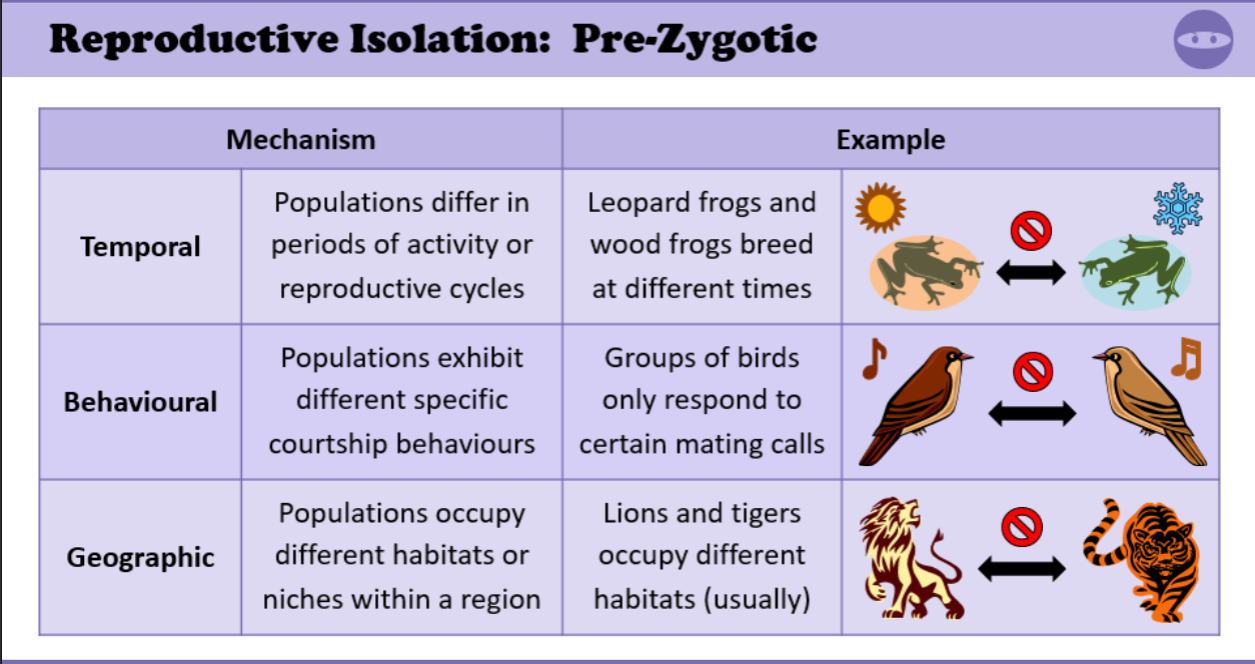
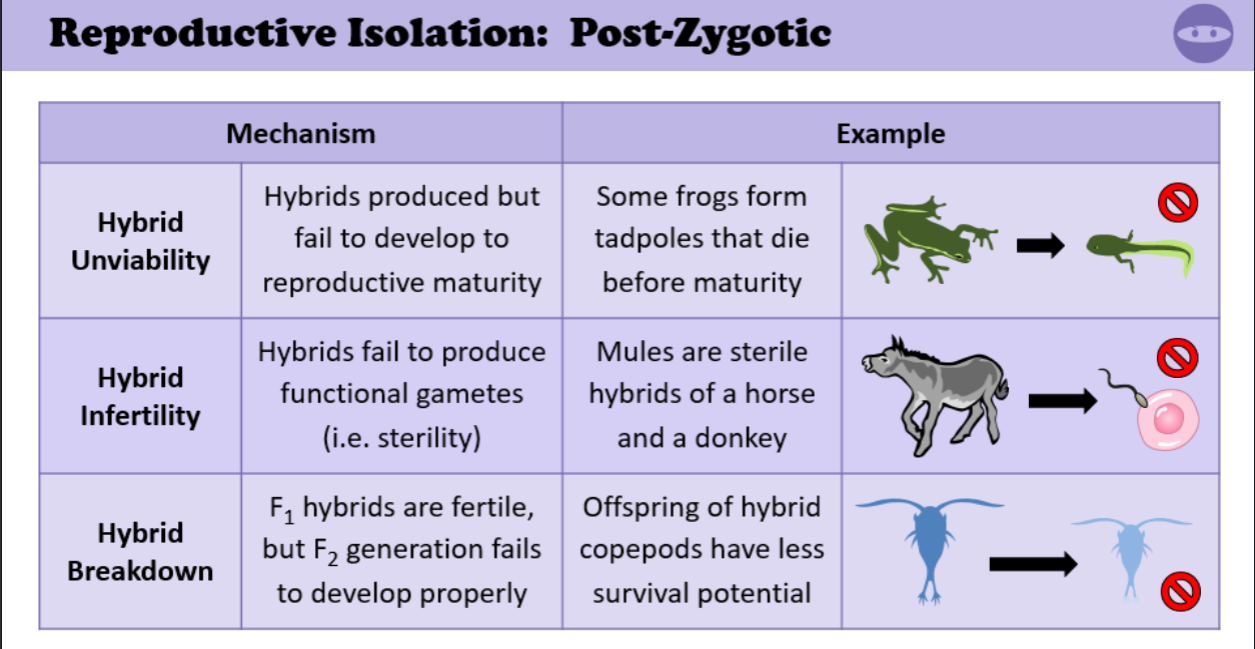
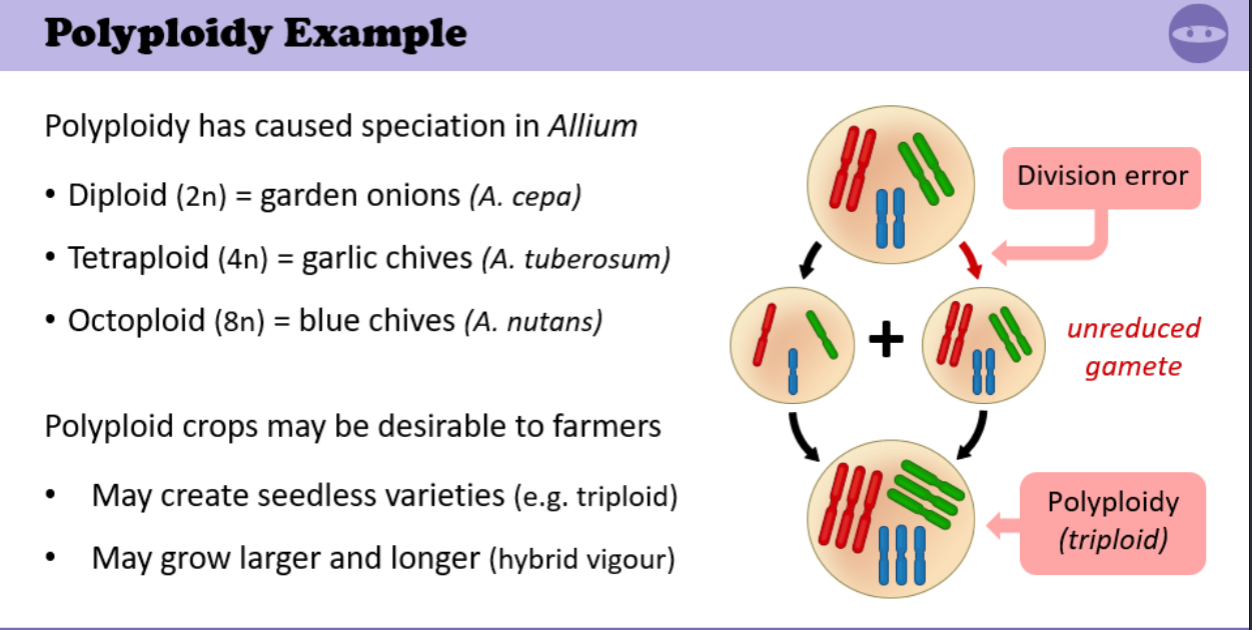
Speciation caveats:
Certain organisms do not reproduce sexually. (e.g. bacteria)
Breeding capacity may be impossible to ascertain from fossil records.
May be impossible for certain members of the same species to mate
Ring species involve interlinking breeding with incompatible ends.

Natural selection:
Three stages of natural selection:
Variation
Adaptation
Selection

Evolutionary theories:
Lamarck:
Organismal change via habitual use and disuse (1801)
Excessive use causes features to develop, continued disuse causes atrophy.
E.g. giraffes grow long necks to reach high leaves.
Darwin + Wallace:
Theory of descent with modification (1859)
Beneficial traits have an adaptive advantage, leading to higher reproduction.
E.g. Long-necked giraffes have more offspring because of their competitive advantage.
Neo-Darwinism:
Combines Darwinian theory with Mendelian genetics.
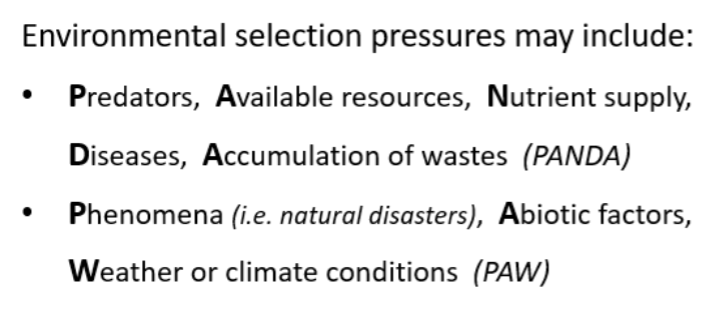
Adaptations:
Structural: Physical differences (e.g. neck length in a giraffe)
Behavioral: Differences in the pattern of activity (e.e. opossums feigning death)
Physiological: Variations in response by vital organs. (e.g. homeothermy)
Developmental: Changes that occur throughout a lifespan (e.g. senescence)
Evidence for evolution:
Paleontology:
Fossils: Preserved remains or traces of organisms from the remote past.
Fossil record: Totality of fossils discovered and undiscovered.
Law of fossil succession: Over time changes occur in ancestral organisms with different species appearing in the fossil records in a systematic order.
Transitional fossil: An intermediary form of an evolutionary pathway that connects species to its ancestor or predicted descendant.
Conditions for fossilisation:
Preservation of remains.
Exposed to high pressure to promote mineralization (e.g. rapid burial)
Subjected to anoxic (low oxygen) conditions to prevent decomposition.

Comparative anatomy (homologous structure):
Homologous structures: Characteristics that share a common basic structure but used in different ways.
Adaptive radiation: A rapid increase in the number of species with a common ancestor when members occupy niches with different conditions.
Niche: The role an organism plays in a community
Vestigial organs: Reduced remnants of functional organs present in ancestors
Selective breeding:
Humans breed animals with desirable characteristics
Leading to the exaggeration of certain traits in domesticated animals.
Biogeography:
Biogeography: Distribution of life forms over different geological areas.
Related species tend to be in close physical proximity.
Exceptions can be explained by continental drift.
 Knowt
Knowt